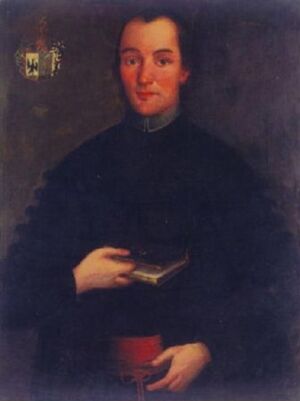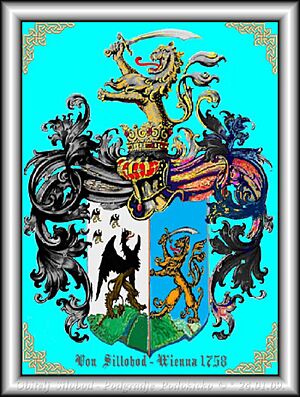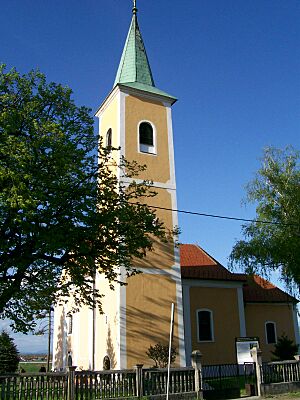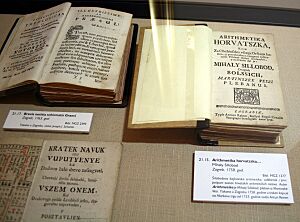Mihalj Šilobod Bolšić facts for kids
Quick facts for kids
Mihalj Šilobod Bolšić
|
|
|---|---|

Portrait
|
|
| Born | 1 November 1724 Podgrađe Podokićko, Kingdom of Croatia (Habsburg)
|
| Died | 4 April 1787 (aged 62) Sveta Nedelja, Kingdom of Croatia (Habsburg)
|
| Alma mater | University of Vienna University of Bologna |
| Known for | Arithmetika Horvatzka |
| Scientific career | |
| Fields | Mathematics, musicology, and Catholicism |
Mihalj Šilobod Bolšić (born November 1, 1724 – died April 4, 1787) was a Croatian Roman Catholic priest, mathematician, and writer. He is best known for writing the first Croatian textbook on arithmetics, called Arithmetika Horvatzka. This important book was published in Zagreb in 1758.
Contents
Biography of Mihalj Šilobod Bolšić
Mihalj was born in Podgrađe Podokićko on November 1, 1724. His parents were Andrija Šilobod and Margareta Gunarić. He was baptized the very next day at the local church.
Mihalj's father, Andrija Šilobod, was an important military officer. He served in the Karlovac Military Generalate, a part of the Habsburg Kingdom of Croatia. Andrija fought against the Turks from 1735 to 1739. Mihalj's brother, Ivan, was also a soldier. In 1758, Queen Maria Theresa of Austria gave Andrija and Ivan noble titles for their military service.

Mihalj first went to school at the Jesuit school in Samobor, near Zagreb. He then studied philosophy at the University of Vienna. After that, he studied theology at the University of Bologna. In 1747, he finished university and became a chaplain. He worked in the towns of Tuhlje and Ivanec. Mihalj worked hard to help poor Croatian communities learn to read and write. He was very special in this effort.
In 1751, Šilobod became a pastor in Martinska Ves. Later, in 1783, he helped fix up the old local church in Sveta Nedelja. He raised the walls, added a new room for priests, and painted the main altar. He also arranged a special tomb for pastors, where he himself is buried. Mihalj even designed and placed a large clock on the church tower. This clock was praised by the monarchy. He also had a brick choir built, which is still used today.
While in Sveta Nedelja, Mihalj strongly supported building the first public school. This school was in Sveti Martin pod Okićem, near his birthplace. His father, Andreas, bought the land for the school from the Catholic Church. With help from the Zrinski family, the land was given to Mihalj. Mihalj drew the school plans and raised money for its stone foundations. He paid for half of the first floor during his lifetime. Sadly, after he passed away, others could not raise enough money to finish the building. If he had lived longer, it would have been the first public school in rural Croatia after the war. Even though it was not finished, the building was used. In 1867, it welcomed its first students. The elementary school there today is still named OŠ Mihaela Šiloboda after him.
Mihalj died in Sveta Nedelja on April 4, 1787. He was buried in one of the tombs in Sveta Nedelja. Mihalj was a very humble person. He never used his family's noble title in his work. His father said that Mihalj always signed his documents simply as "M. Šilobod." This showed his desire to avoid special privileges. In his book Arithmetika Horvatzka, he used both his birth name, Šilobod, and his mother's family name, Bolšić. He did this to honor his grandmother's family, which was very important to him. Many people, including church leaders and military officers, came to his burial.
Major Works and Contributions
Šilobod wrote mostly in Latin and Croatian. Besides his main books, he also wrote poems and songs, mostly in Latin. His most important publications include:
- Zbirka crkvenih pjesama ("Collection of Church Songs"; 1757) – A book of traditional songs and hymns from rural Croatia.
- Arithmetika Horvatszka (1758) – His most famous work, the first Croatian arithmetic textbook.
- Fundamentum cantus Gregoriani seu chroralis (1760) – A guide to Gregorian chant.
- Cabala de lesu Lotto. (1768) – About the game of lotto.
- Cabala, to je na vszakoiachka pitanya kratki ter vendar prikladni odgovori vu horvaczkom jeziku. (Unknown Year) – A small book of answers to questions about the Croatian language and church topics.
Cithara Octochord Collection (1751)
Šilobod helped edit the third edition of the Cithara Octochord Collection in 1751. This collection was important for church music in Zagreb. It included new hymns with fresh words and music. Šilobod played a big part in creating these new hymns.
Zbirka crkvenih pjesama (1757)
After moving to the countryside, Mihalj became very interested in local culture. He started collecting traditional songs and hymns that people sang but were not written down. He gathered many of these songs and published them in Zagreb. The book, called Zbirka Crkvenih Pjesama ("Collection of Church Songs"), came out in 1757. It had almost 300 pages of sheet music.
Arithmetika Horvatzka (1758)
His most famous work is Arithmetika Horvatzka (1758). He wrote it in the Kajkavian dialect of Croatian language. This book created a full system of math terms in Croatian. It used many examples from daily life in Croatia to explain math problems. Šilobod got ideas for his book from other math books, like one by the Italian author Giuseppe Maria Figatelli. The book was published in Zagreb in 1758. It had four parts and was signed by Mihalj Šilobod-Bolšić.
In the 1700s, public schools were not common in the Habsburg Monarchy. Teachers were sometimes hired by towns, or priests taught students. People learned to read and write, but not always to count. Math textbooks were only in foreign languages. So, math had to be taught in Croatian. Mihalj wrote his book to help people learn math and improve their lives. He saw that many local people struggled with basic money and business math. A Croatian mathematician, Mate Zoricic, said that this lack of math skills caused poverty. He noted that foreigners who knew math became rich in Dalmatia, while locals struggled. So, the book was for anyone who could read but did not know Latin. This included business people and farmers. Because of this, the book is full of real-life examples. It also shows how to change one type of money into another.
The Arithmetika Horvatzka was set up like other useful books of that time. The first part teaches the four basic math operations: addition, subtraction, multiplication, and division. The second part covers operations with fractions. The third part explains the simple and complex rule of three. The fourth part deals with real-world business math. This includes accounts, debts, profits and losses, and mixed calculations. This last part also has extra explanations, puzzles, and riddles. These were probably for students who understood the first three parts well. For example, one puzzle asks: "Two fathers and two sons hunted three rabbits, and each liked one rabbit. How can that be?" The answer is: "It had to be a father, his son, and his son's son (a grandson). So, two fathers and two sons each have a rabbit." Šilobod hoped these riddles would make the book more fun to read. The last 36 pages of the book have tables for different uses. Knowing basic accounting and business math was seen as very important. The book's content, explanations, and exercises helped people learn practical math for daily life and business.
Since this was the first math book in Croatian language, it was the first time many Croatian math terms appeared. Šilobod used words from dictionaries, but they were not enough. Dictionaries did not have many advanced math terms. So, Šilobod faced a big challenge. His book would be the first to record the math language of the Kaikavian region. He had to change existing dictionary terms. He also had to create new terms. He did this by using existing Croatian words with similar meanings. He also adapted some Latin terms for Kaikavian use.
Fundamentum cantus Gregoriani seu chroralis (1760)
Fundamentum cantus Gregoriani seu chroralis is considered his second most famous book. It explains the rules of Gregorian chant, a type of church singing. The book has six parts, like conversations. They talk about: how music started (part one); drawing notes and clefs (part two); solmization (part three); intervals (part four); real and plagal tones (part five); and intonation (part six). This book was used as a textbook in the Zagreb seminary for over 100 years. Even today, this work is studied in Rome. It is still seen as a great guide for choral singing.
Legacy and Impact
Šilobod's Arithmetika Horvatzka has great cultural value in Croatia. It was the first time Croatian math words were used in a systematic way. The book also played a key role in education in Croatia. It helped students understand how important accounting was for business and money.
Even 100 years after his death, a famous saying about Arithmetika was still popular: "Ak ne buš učil matematiku išel buš k Šilobodu da te poduči!" This means: "If you didn't learn mathematics, you went to Šilobod to teach you!" His name is also part of other common sayings, especially among Kajkavian people. For example, if someone calculates something wrong, people might tell them to pray to Šilobod. If someone wants to brag about counting correctly, they might say, "It would be the same with Šilobod."
In 2008, Hrvatska pošta (Croatian Post) released a special stamp. It celebrated 250 years since Arithmetika Horvatzka was published. A researcher named Irena Mišurac Zorica said that Mihalj Šilobod Bolšić was a very skilled teacher. He set a high standard for how math should be taught and developed.
Besides the stamp, a scientific meeting was held in Sveta Nedelja to honor Mihalj Šilobod Bolšić. It was the first such meeting for this respected priest and teacher. In 2009, the Samobor Museum published a book. It included writings from seven people who took part in the meeting. These writings help us understand Mihalj's life and achievements. He was a very important person in spreading math education in the 1700s. To celebrate, the Museum also made a copy of the entire Arithmetika Horvatzka book.
Images for kids
See also
- Šilobod
- Sveta Nedelja, Zagreb County
- Samobor
- Croatian literature
- Catholic Church in Croatia
- Timeline of Croatian history
- List of Catholic clergy scientists
- List of Catholic authors
- List of Catholic priests
- List of people from Croatia
- List of Croatian-language poets
- List of noble families of Croatia
- List of important publications in mathematics




